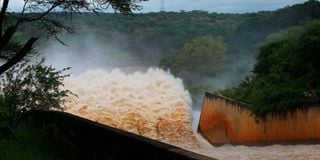Premium
KenGen sounds warning as Masinga Dam water levels hit record high

Masinga Dam. The water level at the dam was recorded at 1,058.22 metres above sea level on May 2, 2024, against a full supply level of 1,056.50 metres.
The Kenya Electricity Generating Company (KenGen) has issued an early warning to communities living near dams and rivers to relocate to higher ground to avoid loss of lives and property.
Managing Director Peter Njenga said the water level at Masinga Dam was recorded at 1,058.22 metres above sea level on May 2, 2024, against a full supply level of 1,056.50 metres. He said such levels were last recorded in 2020.
"We urge those still living near the dams and the Tana River to heed the government's call and move to safer areas," said Eng Njenga.
He said communities living in the Mbondoni site, Kithecu and Menguthe villages were also at risk.
However, Eng Njenga explained that the rise was due to a significant increase in the amount of water currently flowing into the dams, which has averaged more than 850m3 per second over the past week, caused by heavy rains in the dams' catchment areas.
The KenGen boss said the water levels will remain high for most of May 2024 should the ongoing rains continue as predicted by the Kenya Meteorological Department.
"All our major hydropower dams in the Seven Forks have reached full supply capacity and now hold a combined volume of more than 2.6 billion cubic metres against a total flow of the Tana River estimated at five billion cubic metres," he said.
Other dams in the Seven Forks cascade are Kamburu, Gitaru, Kindaruma and Kiambere.
"The Seven Forks dams hold most of the water from the Tana River, well over half the volume that would otherwise flood areas downstream of the dams, thereby reducing the damage caused by the ongoing rains," the KenGen managing director said in a statement.
But Eng Njenga played down the risk of the dams bursting, saying the infrastructure was strong and had all the safety features to withstand the high pressure of the water.
"Thanks to the good water inflows, KenGen has stepped up power generation from its large hydropower plants, giving a reprieve to electricity consumers in Kenya," he added.
"We are constantly monitoring the structure of our dams and wish to assure all Kenyans that the dam safety measures we have put in place, together with our disaster preparedness, are helping to mitigate the risks of water breaching the dam walls," he said.
Eng Njenga said KenGen, with the support of the government, is considering raising the Masinga Dam by 1.5 metres, which will help hold more water and further delay overtopping during heavy rains.
According to Energy and Petroleum Regulatory Authority (EPRA) reports released on 29 April 2024, against a peak demand of 2,033MW, KenGen's hydropower contributed 36.5 per cent while geothermal accounted for 32 per cent, taking KenGen's share to more than 70 per cent of the total electricity consumed in Kenya.
In November 2023, KenGen predicted that the Masinga Dam was likely to reach full supply capacity and spill in April 2024, which is what happened.
KenGen issued an early warning to communities living near the dams and rivers to relocate and move to higher ground to avoid loss of life and property.
"We thank those who took our warning seriously and moved to safer areas and urge those still living near the dams and the Tana River to heed the government's call and move to safer areas," said Eng Njenga.
He said communities living in the Mbondoni site, Kithecu and Menguthe villages were particularly at risk.
"Given the current circumstances, we must prioritise the safety and well-being of our citizens," he added.
According to KenGen, the dams have helped to regulate river flows and mitigate downstream flooding by temporarily storing flood water and allowing it to flow naturally downstream through the power stations.
He said this would be achieved through a robust water management plan to regulate storage and power generation to ensure a healthy ecosystem and less flooding during heavy rains.
"According to the Kenya Meteorological Department's forecast, the rains are likely to continue until the end of May, but we need cheaper power throughout the year, so we are implementing a robust water management plan that will enable us to supply hydropower throughout the year to help stabilise the cost of electricity in Kenya," he said.
KenGen's hydropower capacity currently stands at 826 MW, representing 44 per cent of installed capacity and about 25 per cent of total national capacity.





